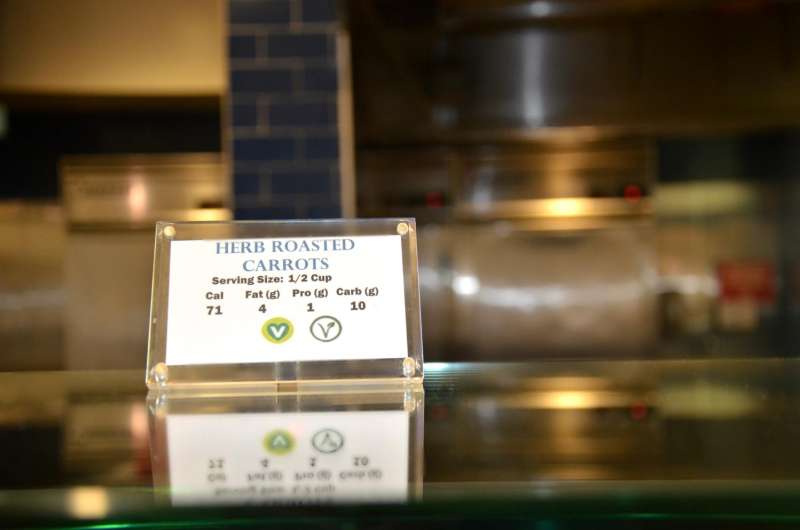Nutrition labels on dining hall food: Are they being used? By who?

Dining halls at the University of Illinois voluntarily label food items with nutrition information but are students using the information to make healthy food choices? A new study shows that students who are already health conscious are the primary users.
"Those who track their food intake by using an app or some other sort of food diary are 6.6 times more likely to use the information on the labels to make food choices. This was the biggest predictor," says U of I food economist Brenna Ellison. "We also found that students who exercised regularly, ate breakfast, and reported good or excellent eating habits were more likely to use nutrition labels."
Ellison and her colleagues surveyed 2,729 university students in four different dining halls. "It's an important population for nutrition studies because they're developing lifelong habits," Ellison says.
After students sat down with their trays of food, they were asked to participate in a written survey. About 45 percent of the students surveyed said they saw the labels but only 20 percent used the information on the labels to make food choices. The surveys were conducted during weeks 4, 8, and 12 of a semester.
"We specifically waited to do the first wave until week 4 of the semester so that the newness of eating in the dining hall had worn off and the student's natural routines had a chance to establish," Ellison says.
Ellison says data collection was spread out over the semester to provide data on label awareness and usage over time. "Being skeptical, I thought usage of labels might go down over time. It was a pleasant surprise that, even with different people taking the study each week, we continued to see similar rates of noticing and using the label even in week 12 of the semester. Ideally, more people would have used the labels as the semester progressed, but at least it does not appear that students' awareness and use are going down."
Of those who didn't use the labels, 61 percent said that they don't care about the information, 32 percent said they already know the information, and 25 percent said they didn't have time to use the information.
"I think that the 'don't-care' factor is an important finding," Ellison says. "We know that 80 percent of the 'don't care' respondents exercised at least once a week, but only 12 percent had taken a college-level nutrition course. So is more education needed? Will it make a difference? Our results suggest promoting other behaviors such as exercise or tracking intake may also encourage label use."
Ellison says this is the first study on dining hall nutrition labeling to look at the relationship between label use and sleep, stress, and exercise.
"With those who exercise, there was a dose response. The more often you exercise, the more likely you are to use the labels. We expected this because people who practice one good behavior are likely to practice a suite of healthy behaviors.
"We didn't know if stress would be a good or a bad influence," she says. "We thought someone under high stress wouldn't have time to look at labels, but what we found is that people who perceived themselves as having higher stress paid more attention to the labels. We didn't find a big effect with sleep, but the survey only captures one data point per person, so it may not represent a regular pattern of sleep."
The survey also asked students what information they wanted to see on labels.
"We found it interesting that the people who didn't use the labels wanted a lot of the information that was already available to them," Ellison says. "They were more likely to say that they wanted vegan and vegetarian items, locally sourced items, and ingredients labeled—information that was already on the labels or available through the dining hall website."
The impetus for the study was to learn if label placement makes a difference in students' awareness. Two of the four dining halls in the study placed nutrition labels above the sneeze guard. The other two dining halls placed the labels directly in front of the food. Ellison says placement doesn't matter after all.
"We thought that students couldn't help but see a label near the food," Ellison says. "If anything, placing the labels closer to the food became problematic." She says food such as pasta sauce regularly splashed onto the label, making more of a mess for the dining hall staff having to remove or replace the labels in the middle of a lunch period. "For practical purposes, it's good that label placement doesn't matter. They really need to be placed above the sneeze guard to keep them clean and legible."
"The Influence of Nutrition Label Placement on Awareness and Use among College Students in a Dining Hall Setting" appears in the Journal of the Academy of Nutrition and Dietetics. It was co-authored by Mary Christoph, Brenna Ellison, and Erica Nehrling Meador.

















